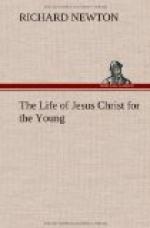We should “hear him” because there is safety in it. We are exposed to dangers every day, and nothing will so help to keep us safe in the midst of these dangers as hearing Jesus, and doing what he tells us to do. Here is an illustration of what I mean.
“Life in the Midst of Danger.” There was an alarm of fire one day, near one of our large public schools. The children in the school were greatly frightened. They screamed, and left their places, and began to rush to the windows and stairs. The stairway leading to the door was soon choked up; and although the fire never reached the school-house, many of the children had their limbs broken and were bruised and wounded in other ways.
But there was one little girl who remained quietly in her seat during all this excitement. When the alarm was over, and the wounded children had been taken home, and order was restored in the school, the teacher asked this little girl why she sat still in her seat, and did not rush towards the door, as the other girls had done.
“My father is a fireman,” she said, “and he has always told me that if ever there was a cry of fire when I was in school, I must remain quiet in my seat, for that was the safest way. I was dreadfully frightened; but I knew that what father had told me was best; and so I sat still, while the others were running to the door.” This little girl heard her father. She minded him. She did what he told her to do, and she found safety in doing so. And if we “hear him” of whom the voice from the Mount of Transfiguration speaks to us—we shall find safety from many a danger.
We ought to learn this lesson of duty, and “hear him,” because there is success in it.
In old times, when the racers were running in the public games, if a man wished to be successful in the race, it was necessary for him to fix his eye on the prize, at the end of the race-course, and keep it fixed there till he reached the end. No one could have any success in racing who did not do this.
Here is an incident about some boys at play that illustrates the point now before us.
“How to Walk Straight.” A light snow had fallen in a certain village, and some of the village boys met to make the best use they could of the new fallen snow. It was too dry for snowballing, and was not deep enough for coasting; so they thought they would improve the occasion by playing at making tracks in the snow.
There was a large meadow near by, with a grand old oak tree standing in the centre of it. The boys gathered round the tree, and stood, on opposite sides, each one with his back against the tree. At a given signal they were to start, and walk to the fence opposite to each of them; and then return to the tree, and see which had made the straightest track.
The signal was given. They started. They reached the fence, and returned to the tree. “Now, boys, who has made the straightest track?” said one of the boys, named James Allison.




